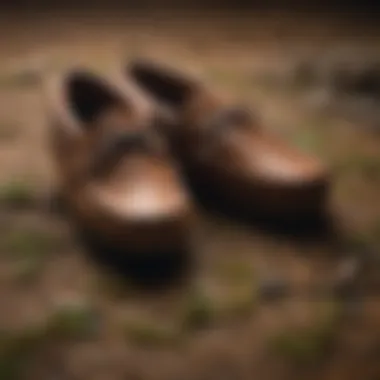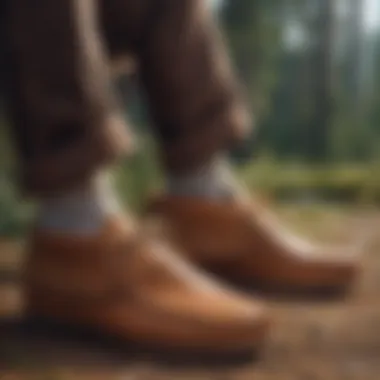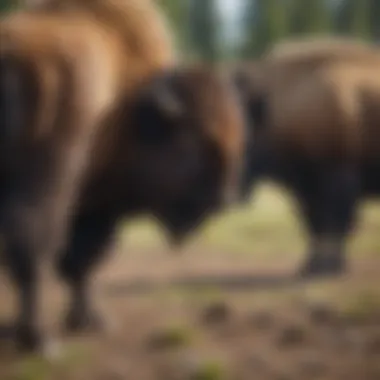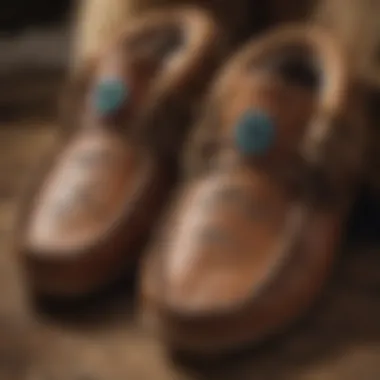The Allure of Bison Driving Moccasins: Style Meets Heritage


Intro
Bison driving moccasins represent more than mere footwear. They embody a rich tapestry of cultural and historical significance. Emerging from Indigenous craftsmanship, these moccasins blend function with fashion. Today, they connect modern wearers to age-old traditions, serving as wearable art. The significance of bison, both ecologically and culturally, cannot be overstated.
This exploration will unveil the intricate relationship between these moccasins and their heritage. Understanding their evolution gives insight into the broader societal contexts in which they exist. We will dissect the craftsmanship that goes into creating each pair.
By the end, you will appreciate not only the aesthetic allure of bison driving moccasins but also their role as symbols of identity and conservation efforts.
Fascinating Facts About the Animal
Unique Characteristics
The American bison is an iconic species, known for its massive size and distinctive hump. These animals can weigh up to 2,000 pounds, making them one of the largest land mammals in North America. Their thick fur provides insulation against harsh winter conditions, while their strong legs allow them to traverse diverse terrains. The bison's striking presence is complemented by its large head and characteristic beard, reminiscent of a powerful creature that roamed these lands for millennia.
Extraordinary Abilities
Bison are notable for their remarkable endurance and adaptability. They possess an impressive sense of smell, which aids them in navigating their environment. In addition, these creatures have a unique digestive system that allows them to efficiently convert tough grass and other forage into energy. Their ability to travel in herds offers a strategic advantage against predators, highlighting their social nature.
The bison represents not only strength but also resilience, having survived near extinction.
Cultural Significance
Animals in Folklore
For many Indigenous cultures, the bison holds a sacred status and features prominently in folklore and spiritual rituals. Stories often illustrate the bison as a benevolent force, providing sustenance and material for shelter and clothing. This connection goes beyond sustenance, representing a profound bond between nature and human existence.
Influence on Art and Literature
Bison motifs frequently appear in traditional art, symbolizing strength and unity. Artists celebrate this animal through various mediums, from textiles to carvings. Additionally, contemporary literature references the bison as a representation of unyielding spirit and connection to the land. The impact of the bison extends to modern fashion, influencing designs like the bison driving moccasins, serving as a reminder of heritage and pride.
The End
The allure of bison driving moccasins lies in their deep historical and cultural roots. They carry stories of generations, fusing elegance with functionality. As we appreciate their beauty, we must also acknowledge the importance of protecting the bison population, ensuring the sustainability of these remarkable animals and their ecosystems. Understanding this intersection of style and heritage provides a richer perspective on what these moccasins represent and their role in our contemporary world.
Prelude to Bison Driving Moccasins
Bison driving moccasins, an intriguing blend of comfort and cultural heritage, warrant exploration for their unique features. They are not merely footwear; they are a reflection of traditions and craftsmanship. This article uncovers their significance, touching on their origin, materials, and impact on modern fashion.
Definition and Overview
Bison driving moccasins are soft, durable shoes made predominantly from bison leather, which is known for its strength and flexibility. The design is typically low-cut, often without a rigid sole, allowing for natural foot movement. This style makes them suitable for driving, hence the name. While they serve a practical purpose, they also present an aesthetic appeal that resonates with consumers seeking not just function but also a connection to cultural heritage.
The appeal of these moccasins extends beyond their utility; they embody craftsmanship that preserves ancient techniques passed down generations. Their rich texture and unique color variations distinguish them from other leather footwear, often leading to their growing popularity in contemporary fashion. Recent trends emphasize comfort and a return to traditional practices, making bison driving moccasins a compelling choice for many.
Cultural Significance in Indigenous Heritage
The cultural background of bison driving moccasins is profound. Among many Indigenous peoples of North America, footwear has always held a significant role. Moccasins were traditionally designed to accommodate the needs of the environment, offering both protection and ease of movement. Bison, an essential resource, contributed not only leather but also sustenance and materials for tools. Thus, the use of bison leather in moccasins represents a deep-seated relationship between the people and the animal.
“Bison moccasins are more than shoes; they embody stories of survival, craftsmanship, and identity.”
Today, the resurgence of interest in bison driving moccasins aligns with a broader movement to restore and honor Indigenous craftsmanship and values. They serve as a bridge between past and present, connecting wearers to a rich historical narrative. This interest also promotes awareness of bison conservation and cultural appreciation, as understanding the origins of these moccasins invites respect for the resources and the traditions they symbolize.
The History of Moccasins


The history of moccasins is a cornerstone of understanding the cultural and functional aspects of bison driving moccasins. This history reflects the journey of footwear from its formative beginnings to its present-day significance. The development and transformation of moccasins over time illustrate societal changes, technological advancements, and shifts in fashion. Knowing the origins and evolution of these shoes provides insight not just into the craft itself, but also into the identities and traditions they represent.
Origins Among Native Tribes
Moccasins have a deep-rooted legacy among Native tribes across North America. Traditionally, these shoes were handcrafted using materials available in the surrounding environment, such as deer or bison hides. The design was practical, adapting to various landscapes and climates. Each tribe had unique styles, often influenced by local customs, resources, and the environment. For example, the Plains tribes favored soft-soled moccasins suited for hunting on grasslands, while the Northeastern tribes often created heavier footwear to withstand colder climates.
The craftsmanship of moccasins was not only a practical necessity but also an art form. Patterns and colors often held symbolic meanings, incorporating important cultural narratives. Moccasins were more than just functional items; they were a representation of cultural identity.
Importantly, these shoes served as a means of storytelling. Intricate beadwork and designs told tales of family, status, or community. Even the choice of material could indicate a person's tribe and their social standing. Through moccasins, individuals expressed their heritage and connection to the land.
Evolution Through the Ages
As time progressed, the evolution of moccasins mirrored broader societal changes. With colonization and the introduction of new materials and technologies, traditional designs began to adapt. The integration of leatherworking tools from European settlers allowed for more refined and varied styles. This marked the beginning of a shift from purely functional footwear to items that also held fashion significance.
In the 19th and 20th centuries, moccasins transitioned into popular fashion items outside Indigenous communities. Artisans began to produce moccasins for a wider market, blending traditional craftsmanship with contemporary designs. Today, bison driving moccasins reflect this blend of heritage and modernity, appealing to consumers who value both style and cultural significance.
Moreover, the resurgence of interest in sustainable and ethically sourced products has led to a renewed appreciation for these shoes. Consumers are more aware of the ecological impact of their purchases. This awareness extends to the choices tribes make in creating and selling moccasins, emphasizing not only craftsmanship but also conservation.
Overall, understanding the history of moccasins offers a layered context for appreciating bison driving moccasins today. They exist at the intersection of practicality, artistry, and meaningful identity, representing both individual and collective histories.
Materials Used in Bison Driving Moccasins
Understanding the materials used in bison driving moccasins is crucial for grasping their unique characteristics and significance in both culture and practicality. Bison leather, primarily sourced from the North American bison, offers distinct advantages that make it a preferred material for this type of footwear. The importance of this topic extends beyond mere aesthetics; it encompasses durability, comfort, and environmental sustainability, all pivotal to the allure of these moccasins.
Bison Leather Properties
Bison leather has several remarkable properties that set it apart from other types of leather. First, it is notably thicker than cowhide, providing enhanced durability. This thickness means that bison leather can withstand wear and tear, making it ideal for moccasins designed for both driving and walking.
Another key feature is its natural grain. Bison leather presents a unique texture that adds character to each pair of moccasins. The grain also contributes to the leather's breathability, ensuring comfort even during extended periods of wear. Furthermore, the leather's natural oils give it a degree of water resistance, protecting the feet from moisture and various elements.
Additionally, bison leather is lighter than many other leathers, which enhances the comfort factor. This is particularly important for driving moccasins, where agility and foot responsiveness are necessary. The supple nature of bison leather allows for easy movement while still providing adequate support.
Comparative Analysis with Other Leathers
When comparing bison leather to other common leathers, such as cowhide or sheep leather, certain differences emerge. Cowhide, while popular, tends to be heavier and less breathable. This can lead to discomfort during long hours of wear. Sheep leather, on the other hand, is very soft and pliable but lacks the durability and structure needed for moccasins that serve multiple purposes.
Here is a brief comparison of the key properties:
- Durability: Bison leather is thicker and tougher than cowhide and sheep leather, which provides significantly longer lifespan.
- Breathability: The texture of bison leather allows for better air circulation compared to the denser cowhide, which can trap heat.
- Weight: Bison leather is lighter than cowhide yet still maintains strength, enabling a comfortable driving experience.
In summary, the choice of materials in bison driving moccasins directly influences their functionality and cultural significance. The properties of bison leather contribute to a footwear option that honors tradition while meeting modern demands. Consumers looking for quality and heritage will find bison driving moccasins not only a practical choice but also a meaningful one.
Craftsmanship and Production Techniques
Craftsmanship and production techniques play a crucial role in the appeal of bison driving moccasins. This section emphasizes how tradition and modernity converge to create footwear that not only serves practical purposes but also embodies cultural heritage and artistry. The intricacies involved in both traditional and contemporary methods reflect the dedication and skill of artisans who bring these moccasins to life, ensuring that every pair tells a story.
Traditional Crafting Methods
Traditional crafting methods for bison driving moccasins are rooted deeply in Indigenous cultures. The process typically begins with the careful selection of bison leather due to its unique properties. Artisans often preference handmade techniques, which can take considerable time and effort. Each moccasin is crafted with great attention to detail, from cutting the leather to stitching it together.
Tools used in these methods are usually simple but effective: awls, needles, and threads made often from natural materials. The use of traditional patterns and designs is common, as these elements reflect the cultural significance of the moccasins. Many artisans incorporate symbols specific to their tribes, honoring their heritage and history in every stitch.
Additionally, the benefits of traditional methods extend beyond aesthetics; the durability of bison leather combined with hand-stitching techniques results in footwear that can withstand wear and tear better than mass-produced alternatives. Some key aspects to note:


- Personalized craftsmanship: Each pair is distinct, often made to order.
- Sustainable practices: Local sourcing of materials reduces ecological impact.
- Cultural preservation: Traditional techniques help maintain and pass down heritage.
Contemporary Manufacturing Practices
Contemporary manufacturing practices bring a different perspective to bison driving moccasins while maintaining respect for traditional values. These methods make use of advanced technologies without compromising quality. In many cases, manufacturers incorporate modern machinery for cutting and stitching, resulting in increased precision and efficiency.
Quality control during production often involves rigorous testing of materials. This ensures that the footwear meets high standards of durability and comfort. Brands focused on contemporary practices frequently align with ethical sourcing principles, providing transparency about their supply chains. This approach not only caters to modern consumer demands but also mirrors a commitment to conservation efforts.
Moreover, contemporary designs often draw inspiration from traditional aesthetics, creating a hybrid that appeals to a broader audience. Some important features to consider in modern manufacturing:
- Enhanced comfort: Modern techniques often focus on ergonomic design, improving usability.
- Wider availability: Products are more accessible via e-commerce channels.
- Innovative styles: New designs incorporate diverse influences while respecting heritage.
Artisans today face the challenge of balancing tradition with innovation, striving to keep the spirit of bison driving moccasins alive in a rapidly changing market.
Functional Aspects of Bison Moccasins
Bison driving moccasins serve more than just a stylistic purpose. They embody a blend of practicality and tradition, designed thoughtfully for daily wear and specific activities. Understanding the functional aspects of these moccasins highlights their enduring appeal and unique contributions to contemporary fashion and culture.
Comfort and Flexibility
One of the core reasons people choose bison driving moccasins is their unparalleled comfort. Made from soft bison leather, these moccasins mold to the foot's shape over time. This personalized fit provides unmatched support and diminishes discomfort, even during long periods of wear.
Flexibility is another hallmark of these moccasins. Unlike more rigid footwear, bison moccasins allow for a full range of motion in the ankle and foot. This adaptability is vital for individuals who require agility in their daily tasks. Whether spending time outdoors or running errands, these shoes accommodate various activities without sacrificing comfort.
Environmental and Ecological Considerations
The topic of environmental and ecological considerations is crucial when discussing bison driving moccasins. As the fashion industry evolves, so does the responsibility toward sustainable practices and conservation efforts. This section addresses the importance of ecological thinking in the creation and use of bison moccasins, highlighting their impact on both the environment and indigenous communities.
Bison Conservation Efforts
Bison once roamed the North American plains in vast herds. Today, they are a symbol of conservation efforts that aim to preserve not just the species, but also the heritage associated with them. Organizations like the National Bison Association work to promote sustainable bison ranching practices that protect the natural habitat of these animals. Such efforts help restore ecosystems while complementing cultural connections to bison.
Moreover, by supporting brands that adhere to these practices, consumers contribute to the survival of bison populations. Some companies source their materials from sustainable farms that prioritize animal welfare and ecological balance. These efforts resonate with culturally aware buyers who value pieces that tell a story, linking them to a larger narrative of heritage preservation.
“Responsible sourcing empowers both the consumer and the producer in a shared mission of conservation.”
Sustainability of Material Sources
Sustainability in the sourcing of materials is fundamental when considering bison driving moccasins. Bison leather, known for its durability and unique qualities, must be gathered from ethical and sustainable sources. This means ensuring that bison are raised in humane conditions while maintaining healthy populations in the wild.
Additionally, the production processes involved in transforming raw bison hide into finished moccasins can also have ecological impacts. Highlights include:
- Minimizing Chemical Use: Opting for vegetable tanned leather reduces harmful chemical pollution, protecting local water sources.
- Waste Minimization: By repurposing scraps and using every part of the animal, manufacturers diminish waste, leading to a more sustainable product lifecycle.
- Energy Efficiency: Brands that embrace energy-efficient production methods contribute to reduced global warming and lower carbon footprints in their operations.
Thus, the sustainability of material sources is not just a trend but a pressing necessity. Understanding these elements encourages consumers to make informed choices that align with ecological principles and support efforts to protect our planet.
Fashion Trends and Social Perception
The significance of fashion trends and social perception cannot be understated when discussing bison driving moccasins. In a world increasingly driven by individual expression, these moccasins serve as a bridge between tradition and contemporary style. Their growing presence in modern wardrobe choices illustrates a shift towards embracing heritage while also prioritizing functional aesthetics.
Adoption in Modern Wardrobes


Bison driving moccasins have transcended their utilitarian origins to find a place in various modern outfits. Their design seamlessly blends comfort with style, making them a popular choice among diverse demographics. People appreciate how these moccasins reflect cultural authenticity, yet they fit into casual and formal attire alike.
The following points highlight their relevance in today’s fashion landscape:
- Versatile Style: Bison moccasins can be paired with jeans, shorts, or dresses. This versatility appeals to consumers looking for stylish yet comfortable footwear.
- Emphasis on Ethics: The use of sustainably sourced bison leather resonates with environmentally conscious buyers. Consumers often seek out products that align with their values.
- Heritage Appeal: The distinct craftsmanship associated with bison moccasins attracts those who value unique, artisanal goods. They symbolize a connection to Indigenous cultures, increasing their desirability.
Bison driving moccasins not only act as fashion statements, but they also embody a deeper appreciation for cultural history. This makes them more than just footwear.
Cultural Appropriation vs.
Appreciation
The rise of bison driving moccasins in mainstream fashion raises important questions regarding cultural appropriation versus appreciation. It is crucial to distinguish between the two, especially in the context of Indigenous heritage.
The line between appropriation and appreciation is often subtle and complex. Careful consideration is required to honor cultural significance.
Some considerations include:
- Respect for Origin: Using bison leather in fashion should involve acknowledging its roots in Indigenous practices. Celebrating the craftsmanship while also giving credit to the cultural significance is vital.
- Consumer Awareness: Educating consumers about the origins and implications of wearing such footwear can foster a deeper appreciation rather than appropriation.
- Collaborative Efforts: Engaging Indigenous artisans and communities in the creation and promotion of bison moccasins helps ensure that traditions are honored and benefitted from.
The discussion surrounding bison driving moccasins illustrates a broader dialogue about cultural integrity in fashion. By navigating these complexities, individuals can choose to celebrate heritage responsibly while enjoying the distinctive style that bison moccasins provide.
The Market for Bison Moccasins
The market for bison driving moccasins is an intriguing blend of tradition and modern consumer behavior. Understanding this market provides insights into not only the value of the products but also the broader implications for both Indigenous craftsmanship and the leather goods industry. When discussing the significance of bison moccasins, it is essential to highlight how they fit into the contemporary retail landscape while keeping their cultural heritage alive.
Trends in E-Commerce and Retail
E-commerce has transformed the way consumers access bison driving moccasins. Traditional brick-and-mortar stores have given way to online platforms that allow for greater visibility. Several online stores focus specifically on handcrafted bison moccasins, showcasing artisans who maintain Indigenous techniques. The rise of platforms like Etsy has enabled these artisans to reach a global audience, connecting a niche market with consumers who value sustainability and craftsmanship.
Moreover, social media plays a significant role in promoting these products. Influencers and fashion enthusiasts often share their experiences and styles featuring bison moccasins, thus perpetuating interest and encouraging purchases. This creates a dynamic interplay between traditional values of craftsmanship and modern marketing strategies that appeal to eco-conscious consumers.
Prices and Accessibility
Pricing for bison driving moccasins varies widely, influenced by factors such as craftsmanship, the use of premium bison leather, and the brand's reputation. On average, moccasins can range from $100 to $400. This price range reflects not only the quality of materials but also the time-intensive labor involved in their creation.
Accessibility remains an important issue. While some consumers can afford high-end moccasins, others may find them prohibitive. There are efforts to make these moccasins more accessible by having price points that cater to different budgets. Additionally, educational initiatives about the benefits of investing in quality footwear can help consumers understand the long-term value, encouraging responsible consumption.
Investing in bison moccasins not only supports Indigenous artisans but also contributes to sustainable fashion choices.
The market for bison driving moccasins reflects a balance between cultural heritage and contemporary consumer trends. As interest continues to grow, both in terms of fashion and ethical considerations, the future looks promising for these unique pieces of footwear.
Closure
The exploration of bison driving moccasins reveals their significance beyond mere footwear. Their relevance reflects a rich cultural narrative that intertwines style with Indigenous heritage. Recognizing this connection enriches one’s understanding of not only the moccasins themselves but also the communities that craft them. The legacy of these articles goes hand in hand with identity, tradition, and artistry.
The Continuing Legacy of Bison Driving Moccasins
Bison driving moccasins carry a tradition that has survived centuries of change. Each pair symbolizes the artistry of Indigenous craftsmanship, reflecting a profound connection to the land and its resources. This legacy is vital in preserving cultural narratives and passing them to future generations. The uniqueness of each pair lies in the materials used, the methods of construction, and the stories embedded in their making.
Moreover, as interest in sustainable fashion increases, bison moccasins serve the modern consumer’s desire for authenticity and durability. They are not only functional but also become a conversation starter about Indigenous rights and bison conservation.
Encouraging Responsible Consumption
In today's global marketplace, the choice of footwear can have far-reaching implications. Encouraging responsible consumption of bison moccasins entails understanding their sourcing and production. By selecting authentic moccasins from reputable artisans, consumers can support Indigenous communities and sustainable practices. Awareness of the ecological footprint is essential. Bison is a finite resource, and its use needs to be managed wisely.
Opting for quality over quantity ensures that each purchase contributes to the craftspeople's livelihoods while promoting conservation efforts. This mindful approach can lead to a trend where consumers are more informed about their choices, favoring brands that uphold ethical standards and environmental responsibility.
By embracing the allure of bison driving moccasins, individuals are not only making a style statement but also supporting a legacy that promotes sustainability and cultural appreciation.







